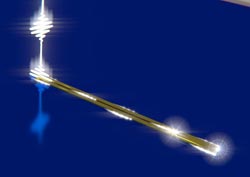Progress in Nano-Optics

Polarized light pulses are fed into a nano-antenna and guided along wires in specific charge wave patterns to be emitted elsewhere.<br><br>(Graphics: Thorsten Feichtner)<br>
In recent years, computer engineers have no longer been able to increase the clock rate of conventional processors. This means that it is not possible to boost computer performance any further without recourse to certain tricks, such as the use of multiple processor cores.
Therefore, researchers are looking for novel concepts. Optical circuits, which operate by means of light particles (photons), look promising in this context – not least because they seem to be suitable for data transmission between quantum computers. Such superfast computers are not yet available, but their implementation is a global research target.
Optical signal transmitted on the nanoscale
The study groups of Professor Bert Hecht and Professor Tobias Brixner at the University of Würzburg have now achieved an important step towards the development of optical circuits: The scientists were able to feed a light signal via an antenna into a waveguide and to have this signal emitted at the other end via another antenna.
What is special about this: The transmission of the optical signal was implemented in tiny structures that can be integrated in today's microelectronics: The antennas and the waveguide measure only a few hundred nanometers. Usually, photons cannot be controlled at such a small scale: “They are extremely unwilling to be confined in small places,” Hecht explains. “Therefore, it is still very hard to combine photonic technologies with the silicon-based technology of conventional computer chips.”
Success with oscillating plasmons
How did the researchers manage to control the photons? They worked with bound photons rather than free photons. These occur, under certain conditions, on the surface of well-conducting metals, such as gold. Incident light can generate there certain electron oscillations, also known as plasmons, which propagate along the metal to emit light elsewhere. Plasmons behave in a similar way to free photons, but they can be concentrated into very small places.
The Würzburg researchers have recently introduced the world's first simple plasmonic circuit in the prestigious journal “Physical Review Letters”. It consists of an approximately 200-nanometer-long antenna, which efficiently captures free photons and converts them to plasmons. This light antenna is connected to a plasmon waveguide, consisting of two fine gold wires, which are about three micrometers long and run parallel to each other. There, the charge waves can spread in exactly two defined patterns – this phenomenon might be used in future to control the direction of movement of the plasmons, which is not possible in the case of electrons.
Strong damping in the circuit
As reported in the journal, the Würzburg researchers first show how the two charge wave patterns can be excited and how this excitation can be experimentally verified. However, the problem is that the plasmons are still strongly dampened on their way through the circuit. “This problem needs to be solved first before the principle can be translated into technological applications,” says Hecht.
The physicists are aware that they have achieved only a small step towards the development of complete optical circuits. “Even so, our results will help to ensure that plasmonic waveguides will remain a highly exciting research topic in future,” says Hecht.
“Multimode plasmon excitation and in-situ analysis in top-down fabricated nanocircuits”, Peter Geisler, Gary Razinskas, Enno Krauss, Xiao-Fei Wu, Christian Rewitz, Philip Tuchscherer, Sebastian Goetz, Chen-Bin Huang, Tobias Brixner, and Bert Hecht, Phys. Rev. Lett. 111, 183901 (2013), DOI: 10.1103/PhysRevLett.111.183901
Contact person
Prof. Dr. Bert Hecht, Institute of Physics, University of Würzburg, T +49 (0)931 31-85863, hecht@physik.uni-wuerzburg.de
Prof. Dr. Tobias Brixner, Institute of Physical and Theoretical Chemistry, University of Würzburg, T +49 (0)931 31-86330, brixner@phys-chemie.uni-wuerzburg.de
Media Contact
More Information:
http://www.uni-wuerzburg.deAll latest news from the category: Physics and Astronomy
This area deals with the fundamental laws and building blocks of nature and how they interact, the properties and the behavior of matter, and research into space and time and their structures.
innovations-report provides in-depth reports and articles on subjects such as astrophysics, laser technologies, nuclear, quantum, particle and solid-state physics, nanotechnologies, planetary research and findings (Mars, Venus) and developments related to the Hubble Telescope.
Newest articles

Silicon Carbide Innovation Alliance to drive industrial-scale semiconductor work
Known for its ability to withstand extreme environments and high voltages, silicon carbide (SiC) is a semiconducting material made up of silicon and carbon atoms arranged into crystals that is…

New SPECT/CT technique shows impressive biomarker identification
…offers increased access for prostate cancer patients. A novel SPECT/CT acquisition method can accurately detect radiopharmaceutical biodistribution in a convenient manner for prostate cancer patients, opening the door for more…

How 3D printers can give robots a soft touch
Soft skin coverings and touch sensors have emerged as a promising feature for robots that are both safer and more intuitive for human interaction, but they are expensive and difficult…





















